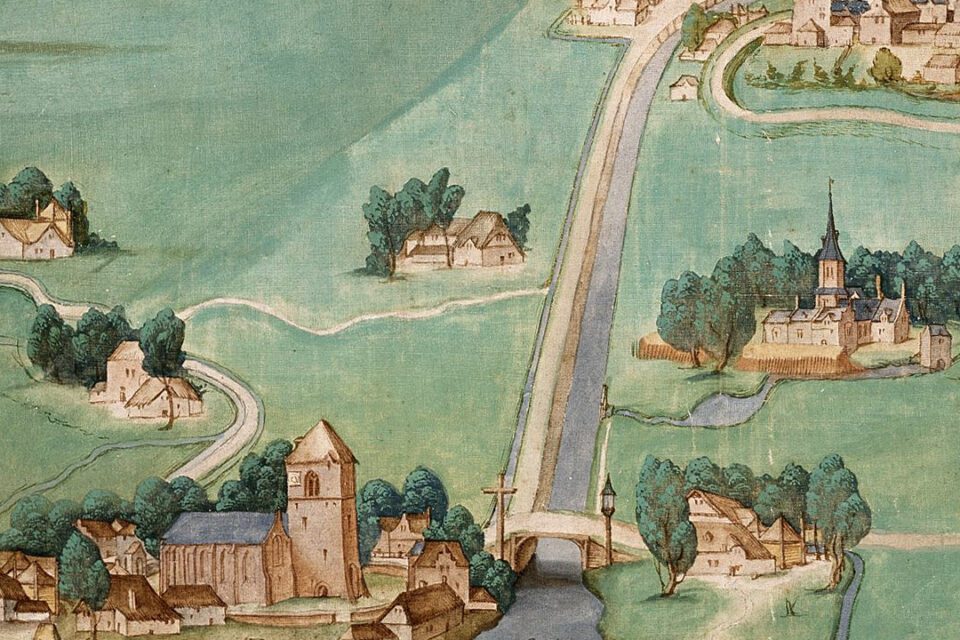In my last post, I asserted that many river basins—specifically in the global South—do not have enough water management infrastructure. In fact, many basins only have a fraction of the infrastructure needed (‘hard & soft’; ‘small & large’) to cope with unprecedented pressure on water resources in a more volatile climate. Consequently, lots of scarce water (rainfall & flood flow) just runs off without productive use and is, in fact, wasted. A period of waste is then typically followed by a period of water shortages (droughts) a few months later. Attenuating this scarcity-surfeit cycle is possible but will require water infrastructure.
Hence there is lots of work to do, and the task at hand sometimes seems overwhelming.
Which brings me to De Schie in Delft—home to the UNESCO-IHE Institute of Water Education and the Delft University of Technology (my alma mater).

Wikipedia mentions that the “original Schie was a swampy creek” along which the city of Delft formed. In the year 1389 the Delfshavensche Schie canal was dug, connecting Delft to the sea.
Indeed, that’s more than 600 years ago. And that number—600 yearsؙ—points to the essence of this blog post: water management infrastructure can remain functional for a very long time.
Physical water management infrastructure such as canals, levees, and storage reservoirs differ from other physical assets (factories, cars, even some bridges) because their essential function does not change very much over time. A canal in the year 1400 has essentially the same functions as a canal in the year 2000.
Consequently, we can take “the long view” and do not have to stay withing the limitations of the ubiquitous ‘cost-benefit analysis’, which is essentially a short-terms economic optimization exercise that considers a time window of 25-50 years, or so, and does not regard, in practice, non-monetary concerns and values (such as biodiversity or creating micro-climates that improve the quality of city life in a warming climate).
Further, because of their longevity, the benefits of well-positioned and well-designed water resources infrastructure extend far into the future and are therefore massively underestimated. Moreover, the functionality of these infrastructure elements—because of their extended functional life span—can adapt with time, and they typically become the nucleus of a ‘beneficial assembly’. De Schie, for example, started as a canal but became a critical node in developing (very productive) polders in the region, served as the city moat of Delft, secured domestic water supply for the city and was probably instrumental in the ‘rise’ of the city, and has been used for recreative and esthetic purposes ever since. It even featured in famous paintings!

On the other side of the coin, the costs of digging De Schie have long since been forgotten. It must have been a very substantial and probably controversial expenditure at that time. What is certain is that these costs have been a fraction of the ultimate benefits of the canal.
In light of the above, it is useful to differentiate between those water infrastructure elements that are ‘timeless’ and those that probably have a restricted life span (such as models or flood-early-warning systems). There is no point using a cost-benefit analysis for the first category. Rather, it’s advised to build and design these elements to the highest possible standard—with a focus on reducing future maintenance costs as much as possible.
That brings this blog post back to those catchments that have inadequate water resources infrastructure to cope with a more extreme climate. Establishing the requisite infrastructure—including nature-based solutions such are reforestation or wetland restoration—is a massive undertaking that will likely exceed the means of any community and will therefore be a multi-generational endeavor. And that is fine. This multi-generational undertaking is per definition incremental. That is also fine.
Just build well. Position carefully. Create beneficial assemblies. Minimize future maintenance. Look for no-regret solutions. Step-by-step. And, by all means, ignore the cost-benefit-analysis.
| Multi-generational water resources management endeavors Building the canal network and patchwork of polders—for which Holland is famous in the water world nowadays—took centuries. It went by leaps and bounds. There was no masterplan at inception. Some projects failed and were abandoned. Others were postponed for many decades. Aspirations waxed and waned. The current generation benefits from a multi-generational effort that gradually and incrementally extended control over more and more of the permanent and temporary wetlands and lowlands, and that transferred them into productive lands. There are many similar examples from other countries. For instance, in response to catastrophic deforestation around 1650, an elaborate system of forest management was established in Japan in the following century. At present, some 80% of Japan’s area is covered by a well-protected forest mantle, which provides valuable ecosystem and hydrological functions. Also in this case, the current generation benefits from investments—i.e. establishing an effective forest management and protection system—made centuries ago. The above examples underscore the long-term nature of natural resources management at scale. “The journey of a thousand miles begins with one step” (Lao Tzu); cliché, yes, but relevant when embarking on this catchment management journey! |
Another water management system that was built over many centuries.
